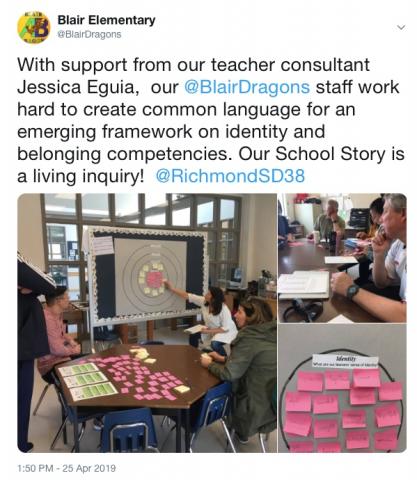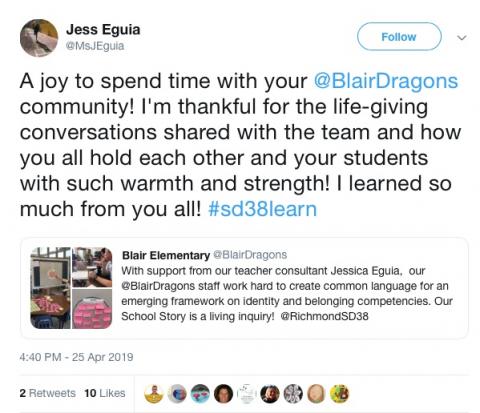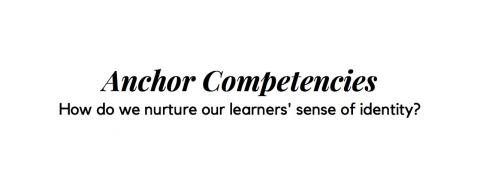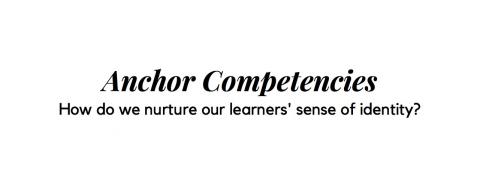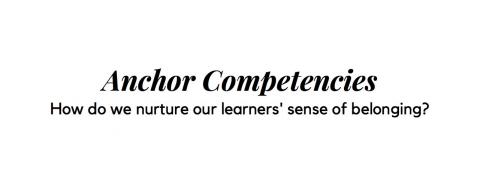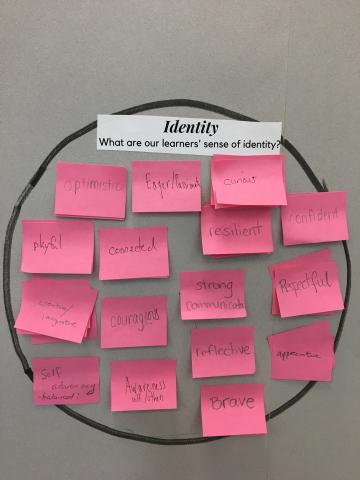Creating a Framework for Identity & Belonging
On a previous collaboration, our staff found several common themes for next steps based on student evidence. Small whispers that helped us make transparent the questions we needed. We were able to Interpret the collection of feedback; all of which directly informed our next Professional Development Day one month later (January 2019) and respectively our in Thirds Day in April 2019. Most specifically, all three groups landed on the following next steps for new learning:
- What is our common language? We need a common language. We don;t have a common language.
- Is there a mentor text to support us? A professional resource we could all read and learn from?
- Can we find a consultant/expert to help us with building a common language around identity and belonging (core competencies)?
To be responsive, we promptly invited one our Teacher Consultants (Curricular Implementation K-7), Jessica Eguia in for a meeting. We shared the documentation from our Thirds Day and asked her to help us design our next steps. I believe that it is essential to seek supports beyond our four walls. Broadening our perspectives, networking, partnering and valuing expertise will fertilize our inquiry and help place our work within a broader context promoting “…horizontal connectedness…with which our educators are connected.” (OECD, 2017, pg. 26). We came up with a plan to develop common language as it pertains to identity and belonging:
- Have teachers dive deeper in to connecting the Personal and Social Core Competencies with their grade’s curricular competencies. The purpose is to help teachers integrate the two and explore how the two connect. It is our feeling that this is ground work in creating a common language for our staff and students to use. At our next Professional Development Day teachers worked in grade groups to make these connections. We designed a framework to document their work and their work is shared on our Staff Portal as an artifact and in a group share at the end of the day. We framed their work like this:
Thinking, Sharing, Connecting
Purpose: To connect our school story to what we do every day & to find curricular connections in authentic ways with the goal to help us develop a common language.
In grade groups, brainstorm concepts that connect the core competencies & our school story question to curricular areas
Share learning experiences that might bridge core competencies with curricular areas
Documents to be downloaded from Portal:
“Connecting our school story to the curriculum”
Core competencies chart (as reference) “Staff Document” “Core Competencies – sharing folder” “Checklist CC”
- Visit the Richmond Museum - Our team thought that it was time to become students and reflect on a collection at the Richmond Museum: What curricular connections or connections to our school story might live within this exhibit or experience? So we visited the “Every Collector Has a Story” exhibit and spent time making connections to school story and our curriculum. Two members of my wonderful Professional Development Committee (Karen Choo & April Pikarrainen) made provocations for the experience (see Appendix 3) to help guide the experience for our staff. We also used art materials to engage our our thoughts artistically. We shared out after how belongings and collections communicate ideas and identity. We looked deeply at how the museum so carefully told a story and how through the exhibit (evidence) all of us took in new learning about ourselves, the collectors and the overall theme. Fascinating and exciting! Our staff learning through the arts. It is very important to step outside the traditional forms of new learning (texts/speakers/reflection, etc…) and see how we can be humbly moved to ask new questions via other modalities (just like we do for our students).
- Finding a Mentor Text - we are searching. Once we find a text I will purchase all staff members a copy and we will integrate it into our collaborative time, Thirds Days and Professional Development Days. It will be an embedded - a live book study.
- Jessica Eguia, Teacher Consultant came again to work with the grade groups on a Thirds Day to take their connections and create student friendly, common language that will support our School Goal. The intention is that we are all using the same language and that this will bring a greater depth of understanding and knowing and to help our students actualize the core competencies across the curriculum.
What are words that come to mind when we think about identity? We used dispositions to spark our thinking. John Hattie recommends dispositions and values of how we what them to “be” and and live. What words come to mind when you think about characteristics that we hope for our students. Teachers worked collaboartively to co-constuct an emerging framework that we will use.
